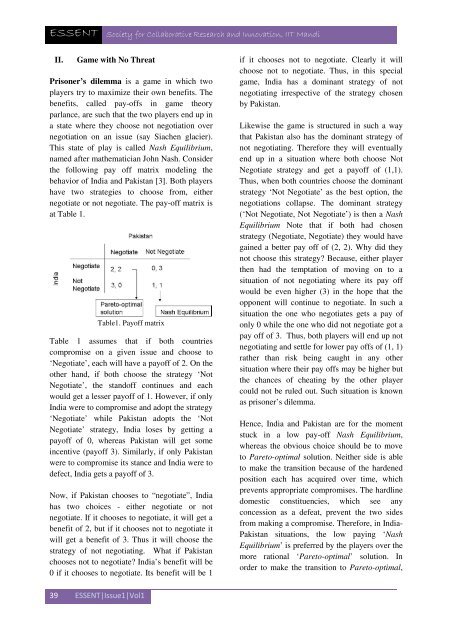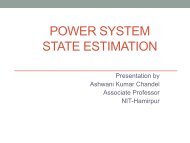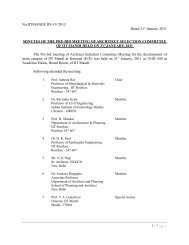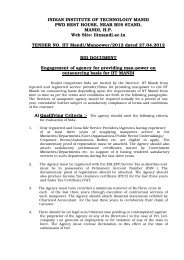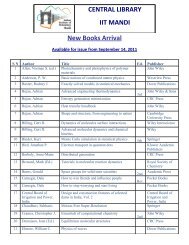Issue1. Vol.1 (April, 2013) - IIT Mandi
Issue1. Vol.1 (April, 2013) - IIT Mandi
Issue1. Vol.1 (April, 2013) - IIT Mandi
- No tags were found...
Create successful ePaper yourself
Turn your PDF publications into a flip-book with our unique Google optimized e-Paper software.
ESSENT Society for Collaborative Research and Innovation, <strong>IIT</strong> <strong>Mandi</strong>II.Game with No ThreatPrisoner’s dilemma is a game in which twoplayers try to maximize their own benefits. Thebenefits, called pay-offs in game theoryparlance, are such that the two players end up ina state where they choose not negotiation overnegotiation on an issue (say Siachen glacier).This state of play is called Nash Equilibrium,named after mathematician John Nash. Considerthe following pay off matrix modeling thebehavior of India and Pakistan [3]. Both playershave two strategies to choose from, eithernegotiate or not negotiate. The pay-off matrix isat Table 1.Table1. Payoff matrixTable 1 assumes that if both countriescompromise on a given issue and choose to‘Negotiate’, each will have a payoff of 2. On theother hand, if both choose the strategy ‘NotNegotiate’, the standoff continues and eachwould get a lesser payoff of 1. However, if onlyIndia were to compromise and adopt the strategy‘Negotiate’ while Pakistan adopts the ‘NotNegotiate’ strategy, India loses by getting apayoff of 0, whereas Pakistan will get someincentive (payoff 3). Similarly, if only Pakistanwere to compromise its stance and India were todefect, India gets a payoff of 3.Now, if Pakistan chooses to “negotiate”, Indiahas two choices - either negotiate or notnegotiate. If it chooses to negotiate, it will get abenefit of 2, but if it chooses not to negotiate itwill get a benefit of 3. Thus it will choose thestrategy of not negotiating. What if Pakistanchooses not to negotiate? India’s benefit will be0 if it chooses to negotiate. Its benefit will be 1if it chooses not to negotiate. Clearly it willchoose not to negotiate. Thus, in this specialgame, India has a dominant strategy of notnegotiating irrespective of the strategy chosenby Pakistan.Likewise the game is structured in such a waythat Pakistan also has the dominant strategy ofnot negotiating. Therefore they will eventuallyend up in a situation where both choose NotNegotiate strategy and get a payoff of (1,1).Thus, when both countries choose the dominantstrategy ‘Not Negotiate’ as the best option, thenegotiations collapse. The dominant strategy(‘Not Negotiate, Not Negotiate’) is then a NashEquilibrium Note that if both had chosenstrategy (Negotiate, Negotiate) they would havegained a better pay off of (2, 2). Why did theynot choose this strategy? Because, either playerthen had the temptation of moving on to asituation of not negotiating where its pay offwould be even higher (3) in the hope that theopponent will continue to negotiate. In such asituation the one who negotiates gets a pay ofonly 0 while the one who did not negotiate got apay off of 3. Thus, both players will end up notnegotiating and settle for lower pay offs of (1, 1)rather than risk being caught in any othersituation where their pay offs may be higher butthe chances of cheating by the other playercould not be ruled out. Such situation is knownas prisoner’s dilemma.Hence, India and Pakistan are for the momentstuck in a low pay-off Nash Equilibrium,whereas the obvious choice should be to moveto Pareto-optimal solution. Neither side is ableto make the transition because of the hardenedposition each has acquired over time, whichprevents appropriate compromises. The hardlinedomestic constituencies, which see anyconcession as a defeat, prevent the two sidesfrom making a compromise. Therefore, in India-Pakistan situations, the low paying ‘NashEquilibrium’ is preferred by the players over themore rational ‘Pareto-optimal’ solution. Inorder to make the transition to Pareto-optimal,39 ESSENT|Issue1|Vol1


